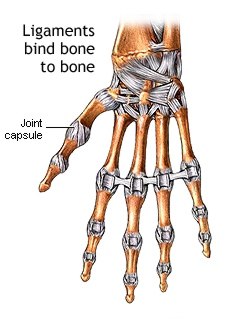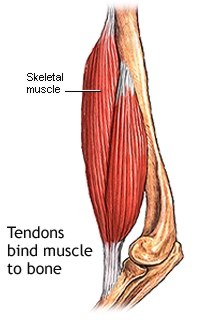Sprains
A sprain is a stretch and or tear of a ligament (a band of fibrous tissue that connects two or more bones at a joint). One or more ligaments can be injured at the same time. The severity of the injury will depend on the extent of injury (whether a tear is partial or complete) and the number of ligaments involved. A sprain can result from a fall, a sudden twist, or a blow to the body that forces a joint out of its normal position and stretches or tears the ligament supporting that joint.
Symptons:
Strains
A strain is an injury to either a muscle or a tendon (fibrous cords of tissue that connect muscle to bone). Depending on the severity of the injury, a strain may be a simple overstretch of the muscle or tendon, or it can result from a partial or complete tear. A strain is caused by twisting or pulling a muscle or tendon. Strains can be acute or chronic. An acute strain is associated with a recent trauma or injury; it also can occur after improperly lifting heavy objects or overstressing the muscles.
Symptons:
First Aid for sprains and strains
It is important that moderate and severe sprains and strains be evaluated by a health care provider to allow prompt, appropriate treatment to begin. Severe sprains and strains may require surgery to repair the torn ligaments, muscle, or tendons. Basic treatments for sprains and strains are similar and should be applied in two stages.
Stage 1 - The goal during the first stage is to reduce swelling and pain. A formula of rest, ice, compression, and elevation (RICE) for the first 24 to 48 hours after the injury is usually advised at this time.
- Rest
Reduce regular exercise or activities of daily living as needed. - Ice
Apply an ice pack wrapped in a towel to the injured area for 20 minutes at a time, four to eight times a day. To avoid cold injury and frostbite, do not apply the ice for more than 20 minutes. - Compression
Swelling of an injured ankle, knee, or wrist may be reduced by using compression. Examples of compression bandages are elastic wraps, special boots, air casts, and splints. - Elevation
If possible, keep the injured ankle, knee, elbow, or wrist elevated on a pillow, above the level of the heart, to help decrease swelling.
Stage 2 - The second stage of treating a sprain or strain is rehabilitation, with the overall goal of improving the condition of the injured area and restoring its function. An exercise program designed to prevent stiffness, improve range of motion, and restore the joint's normal flexibility and strength should be implemented.
Dislocations
A dislocation is an injury to a joint - a place where two or more of your bones come together - in which the ends of your bones are forced from their normal positions. The cause is often a fall or a blow. Some joints, such as your shoulder, may have an increased risk of repeat dislocation.
2.) Control Swelling
- Apply ice pack for 20 minutes 4 to 8 times a day. Do not place ice directly against the skin.
3.) Control Pain
- Give medication such as acetaminophen (Tylenol) or ibuprofen (Advil, Motrin) for pain and swelling. Avoid ibuprofen and other NSAIDs if the person has heart failure or kidney failure.
4.) Seek advanced medical attention as soon as possible.
Fractures
A fracture is a partial or complete break in the bone. Although usually the result of trauma, a fracture can be caused by an acquired disease of bone such as osteoporosis. When a fracture occurs, it is classified as either open or closed.
First Aid for fractures
- Don't move the person except if necessary to avoid further injury.
- Stop any bleeding.
- Immobilize the injured area.
- Apply a splint to the area above and below the fracture sites.
- Apply ice packs to limit swelling and help relieve pain. Do not apply ice directly to the skin.
- Treat for shock.
- Seek advanced medical attention as soon as possible.




